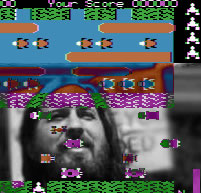

| T.A.Z. Take_Away_Zone #1 |
ART IN THE AGE OF HACKING | at FORUM STADTPARK
- Graz February, 28th - March, 1st 2003 |
|||||||
| T.A.Z. Take_Away_Zone #2 |
|||||||||
| A
[HI]STORY[-TELLING] OF HACKER CULTURES · Year Zero (!) · 1967 PDP-10 - Hacker ethic - ARPAnet · The 1970s Community Memory Group - Felsenstein - Birth of computer underground - Blue Box and Apple · The 1970s The rise of Unix · The 80s Phrack - Free Software Foundation - 2600 · The 90s The "hacker crackdown" and after - The Intel 386 chip - Linux - DeCSS |
 The 80s 1983: . The Berkeley variant of Unix running became the main working system for hackers. Microcomputers were growing in power rapidly. |
||||||||
| 1984 Eric Corley, who uses the hacking handle "Emmanuel Goldstein," starts 2600: The Hacker Quarterly in New York, which quickly becomes a clearinghouse for hacking information. | |||||||||
Richard Stallman went on to form the Free Software Foundation and dedicate himself to producing high-quality free software. It was also around this time that microchip and local-area network technology began to have a serious impact on hackerdom. Ethernet and the Motorola 68000 microchip made a potentially potent combination, and several different startups had been formed to build the first generation of what we now call workstations. 1985 Underground journalists "Taran King" and "Knight Lightning" launch Phrack, an electronic magazine based in St. Louis that provides information about computer hacking. By 1995, when Unix became a commercial product for the first time, the most important fault line in hackerdom was between a relatively cohesive "network nation" centered around the Internet and Usenet (and mostly using minicomputer- or workstation-class machines running Unix), and a vast disconnected hinterland of microcomputer enthusiasts. Within networked hackerdom itself, the big rivalry of the 1980s was between fans of Berkeley Unix and the AT&T versions. Berkeley hackers liked to see themselves as rebels against soulless corporate empires. AT&T Unix never caught up with BSD/Sun in the marketplace, but it won the standards wars. By 1990, AT&T and BSD versions were becoming harder to tell apart, having adopted many of each others' innovations. 1986: Computer Fraud and Abuse Act 1987 A 17-year-old high school dropout named Herbert Zinn, known to authorities as Shadow Hawk, admits he broke into AT&T computers at Bedminster, N.J. Federal authorities say the teen - who worked from a computer in the bedroom of his suburban Chicago home - was close to tapping into AT&T's internal operations and the company's central switching system. Zinn, becomes one of the first people prosecuted under the Computer Fraud and Abuse Act , which among other things makes it illegal to use another person's password.
|
|||||||||